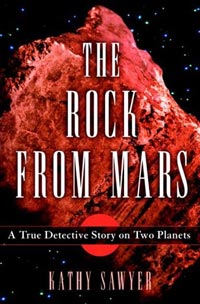Review: The Rock from Marsby Jeff Foust
|
| Of particular interest will be the details Sawyer provides about the machinations within NASA and the White House in the weeks leading up to the announcement, including then-NASA administrator Dan Goldin’s meetings on the subject with President Clinton and Vice President Gore. |
The Rock from Mars doesn’t end with the discovery, of course, covering the aftermath of the August 7, 1996 press conference at NASA Headquarters with the reaction—much of it surprisingly visceral and negative—from the scientific community. Planetary sciences meetings became hotbeds for vigorous, vociferous debate on the evidence in the original 1996 paper. Camps of scientists on both sides of the issue—either for or against a Martian biological explanation for the features seen in ALH84001—emerged, with little sign of an emerging consensus, only the exchange of papers and presentations. Little wonder, then, that ALH84001 has faded from our collective consciousness: from a scientific standpoint, there’s still an ongoing debate about its significance.
While many of those details may already be familiar to potential readers, what sets The Rock from Mars apart is both the background Sawyer provides and the little-known details about the discovery. She fleshes out the histories and personalities of many of the key players in this saga, including the scientists involved with the story, turning them from abstract characters into real people. Of particular interest to many will be the details Sawyer provides about the machinations within NASA and the White House in the weeks leading up to the announcement, including then-NASA administrator Dan Goldin’s meetings on the subject with President Clinton and Vice President Gore. Perhaps the only stumble in the book towards the end, where Sawyer recounts a debate at an astrobiology conference in 2002 between William Schopf, the UCLA paleobiologist who was a noted critic of the discovery (he was the one who quoted the Carl Sagan dictum about “extraordinary claims require extraordinary evidence” at the August 1996 press conference) and a British scientist—not about life on Mars but about an earlier discovery by Schopf about fossil evidence for early life on Earth. The debate underscored the difficulty in understanding the formation of terrestrial life, let alone any Martian life, but probably didn’t require the level of detail presented in the book.
In the final chapter of The Rock from Mars, Sawyer notes that regardless of the scientific interpretation of ALH84001, the August 1996 announcement and its aftermath had numerous effects, from illustrating the scientific and technical challenges of finding evidence of life in rock samples (and the difficulty involved in bringing additional samples back to Earth uncontaminated), to the outpouring of public support for such research. “Like a living thing,” she concludes, “the rock had altered its adopted habitat in mischievous and interesting ways. Like a Siren, it lured its discoverers irresistibly toward its treacherous and baffling source. Like a teacher, it instructed us in our ignorance and in the wondrous possibility forged by human audacity.” That may indeed turn out to be the enduring legacy of ALH84001.
